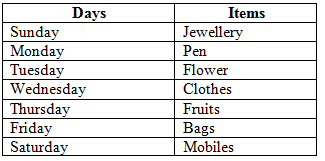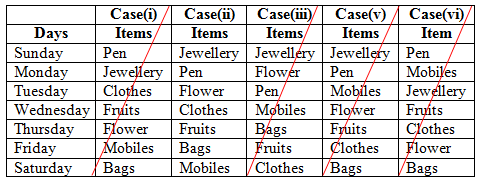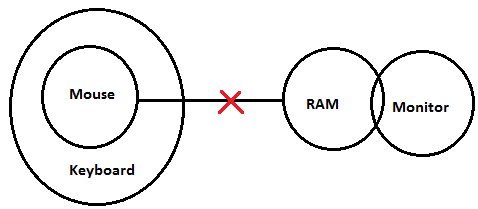Dear Readers, Bank Exam Race for the Year 2018 is already started, To enrich your preparation here we have providing new series of Practice Questions on Reasoning Ability- Section. Candidates those who are preparing for IBPS Clerk Prelims 2018 Exams can practice these questions daily and make your preparation effective.
[WpProQuiz 4079]
Click here to view Reasoning Questions in Hindi
Direction (1-5): Read the following information carefully and answer the questions given below.
A shopkeeper is selling seven different items in seven different days in a week. The week days are starting from Sunday to Saturday. The Items are namely Clothes, Bags, Mobiles, Fruits, Jewellery, Pens and Flowers. All the information is not necessary to be in the same order.
The shopkeeper is selling only two items between selling Pen and Fruits. The shopkeeper is selling only one item between selling Fruits and Mobiles. The shopkeeper is not selling Flowers any day before Jewellery. Only two items are selling between Mobiles and Clothes, who is not selling any day before selling Pen. More than two items are selling between Jewellery and Bags. Not more than one items are selling between Pen and Flower. The shopkeeper is not selling Bag on last day of the week. Jeweller and Flowers are not selling in consecutive days.The shopkeeper is not selling Fruits any day before Pen.
1) Which of the following item is selling on last day of the week?
a) Pens
b) Jewellery
c) Clothes
d) Flowers
e) None of these
2) How many items are selling after selling clothes?
a) One
b) Two
c) Three
d) More than three
e) None
3) The seller selling flowers on which of the following days?
a) Monday
b) Tuesday
c) Wednesday
d) Friday
e) Sunday
4) In which of the following day, does the shop keeper is selling Jewellery?
a) Monday
b) Tuesday
c) Wednesday
d) Friday
e) Sunday
5) How many Items are selling before Flowers?
a) One
b) Two
c) Three
d) More than three
e) None
Direction (6-8): In these questions, relationship between different elements is shown in the statements. These statements are followed by two conclusions:
a) Only conclusion I follows
b) Only conclusion II follows
c) Either conclusion I or conclusion II follows
d) Neither conclusion I nor conclusion II follows
e) Both conclusion I and conclusion II follows
6)
Statement: J = R < K = E ≥ O ≤ X = C > U ≤ Z
Conclusion:
I). J > U
II). E = J
7)
Statement: H < J ≤ S > P = W ≤ Q = P < A ≥ Z = X
Conclusion:
I). A > H
II). H ≥ A
8)
Statement: E > W = O ≥ X = S ≤ A < M = R
Conclusion:
I). X < R
II). E = S
Directions (9-10): In each of the questions below are given two/three statements followed by two conclusions numbered I and II. You have to take the given statements to be true even if they seem to be at variance with commonly known facts. Read all the conclusions and then decide which of the given conclusions logically follows from the given statements, disregarding commonly known facts. Give answer
(a) If only conclusion I follows.
(b) If only conclusion II follows.
(c) If either conclusion I or conclusion II follows.
(d) If neither conclusion I nor conclusion II follows.
(e) If both conclusion I and conclusion II follow.
9)
Statement:
All Mouse are Keyboard
Some Monitor are RAM
No RAM are Mouse
Conclusion:
I). Some Monitor are not Mouse
II). All Keyboard are RAM
10)
Statement:
No IBPS are SBI
Some SBI are SSC
No SSC are UPSC
Conclusion:
I). All SBI being UPSC are possible
II). All UPSC being IBPS are possible
Answers:
Direction (1-5):

i). The shopkeeper is selling only two items between selling Pen and Fruits. The shopkeeper is not selling Fruits any day before Pen.
ii). The shopkeeper is selling only one item between selling Fruits and Mobiles.
iii). The shopkeeper is not selling Flowers any day before Jewellery.
iv). Only two items are selling between Mobiles and Clothes, who is not selling any day before selling Pen.

Case(iv), Case(vii) –> does not follow condition(iv)
v). More than two items are selling between Jewellery and Bags.
vi). Not more than one items are selling between Pen and Flower.
vii). The shopkeeper is not selling Bag on last day of the week.
viii). Jeweller and Flowers are not selling in consecutive days.

Case (i), Case(vi) –> does not follow condition (vi)
Case (iii) –> does not follow condition (viii)
Case (v) –> does not follow condition (vii)
1) Answer: e)
2) Answer: c)
3) Answer: b)
4) Answer: e)
5) Answer: b)
6) Answer: d)
I). J = R < K = E ≥ O ≤ X = C > U (False)
II). J = R < K = E (False)
7) Answer: c)
H < J ≤ S > P = W ≤ Q = P < A –>A> H or H > A or A = H
8) Answer: a)
I). X = S ≤ A < M = R (True)
II). E > W = O ≥ X = S (False)
9) Answer: a)

10) Answer: b)

Daily Practice Test Schedule | Good Luck
| Topic | Daily Publishing Time |
| Daily News Papers & Editorials | 8.00 AM |
| Current Affairs Quiz | 9.00 AM |
| Current Affairs Quiz (Hindi) | 9.30 AM |
| IBPS PO Mains – Reasoning | 10.00 AM |
| IBPS PO Mains – Quantitative Aptitude | 11.00 PM |
| Vocabulary (Based on The Hindu) | 12.00 PM |
| IBPS PO Mains – English Language | 1.00 PM |
| IBPS PO/Clerk – GK | 3.00 PM |
| Daily Current Affairs Updates | 5.00 PM |
| IBPS Clerk Prelims – Reasoning | 6.00 PM |
| IBPS Clerk Prelims – Reasoning (Hindi) | 6.30 PM |
| IBPS Clerk Prelims – Quantitative Aptitude | 7.00 PM |
| IBPS Clerk Prelims – Quantitative Aptitude (Hindi) | 7.30 PM |
| IBPS Clerk Prelims – English Language | 8.00 PM |





